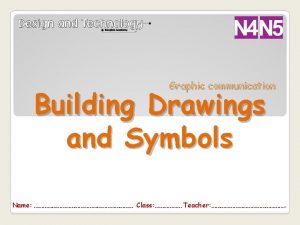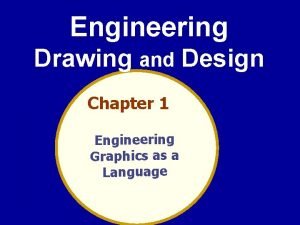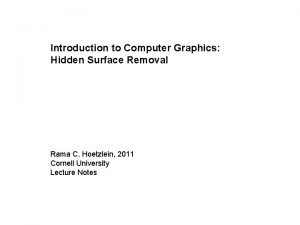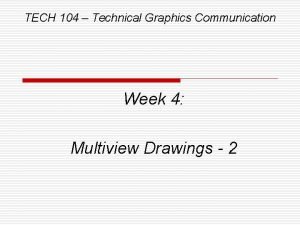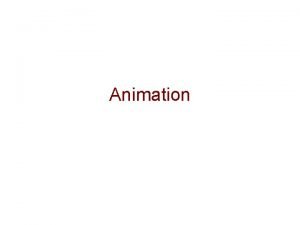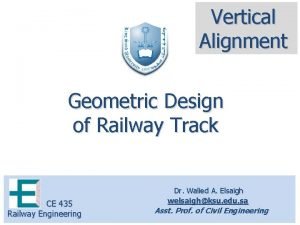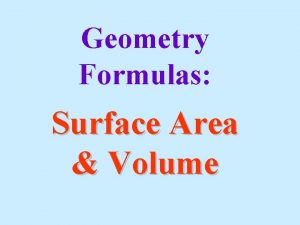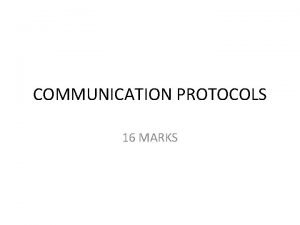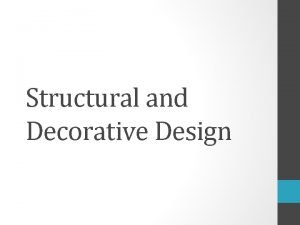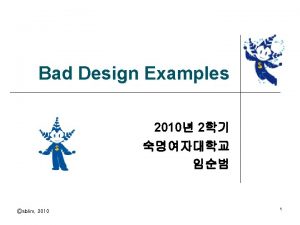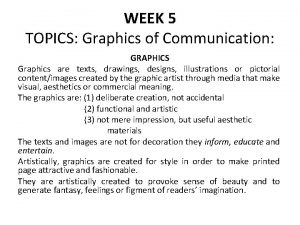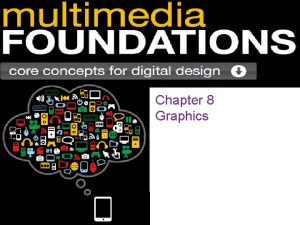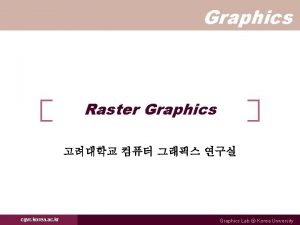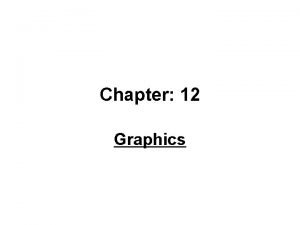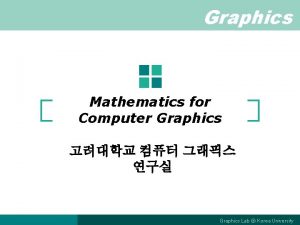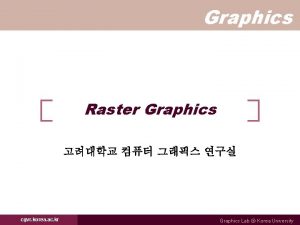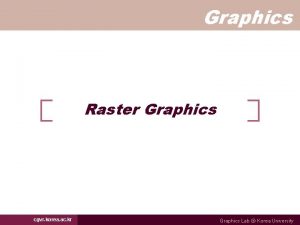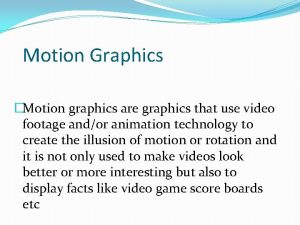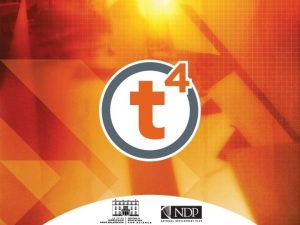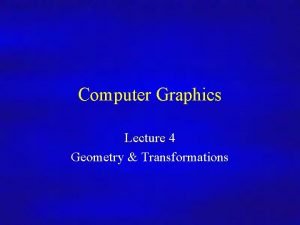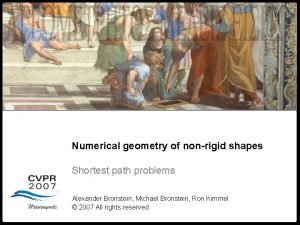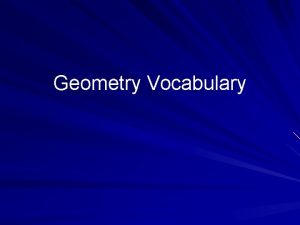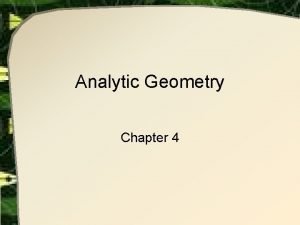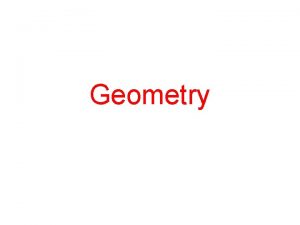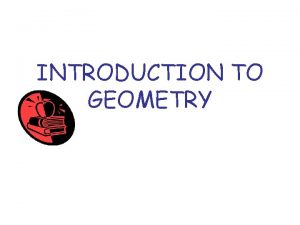Design and Communication Graphics Surface Geometry Surface Geometry

































- Slides: 33

Design and Communication Graphics Surface Geometry

Surface Geometry 1 At the end of this sheet, the students should be able to • • Project a two dimensional view of a solid from its axonometric view on to one of the principal planes of reference Establish/determine the dihedral angles between adjacent plane surfaces on solid objects using the point view method Key Principles: The true size of the dihedral angle between two plane surfaces is seen in a view showing the two planes as edges. Since a plane is seen as an edge in any view in which a line on the plane appears as a point, a view showing a point view of the line of intersection gives an edge view of each of the planes A line is shown in true length when the line of sight is perpendicular to the line

Surface Geometry 1

Surface Geometry 2 At the end of this sheet, the students should be able to • Determine the dihedral angles between adjacent plane surfaces Key Principles: In these problems, the line of intersection of the two planes is given. To produce a view showing the dihedral angle: Ø Obtain a view which shows the line of intersection as a true length Ø Project a view showing the point view of the line of intersection

Surface Geometry 2

Surface Geometry 3 At the end of this sheet, the students should be able to • • Determine the dihedral angles between adjacent plane surfaces forming solid objects using the rabatment method Determine the development of surfaces of pyramidal frustums Key Principles of the rabatment method : A plane is set up at right angles to the line of intersection to cut the planes A and B The dihedral angle is the true size of the angle between the traces of this cutting plane on the planes A and B The true size of the dihedral angle is seen in a view showing the true shape (development) of the cutting plane The development of a surface gives its true shape

Surface Geometry 3

Surface Geometry 4 At the end of this sheet, the students should be able to • Prepare surface developments of surface containers and sheet metal fabrications Key Principles: The development of a surface is the construction of a pattern that represents the unfolded or unrolled surface of the form as shown in the sheet metal model below

Surface Geometry 4

Surface Geometry 5 At the end of this sheet, the students should be able to • Prepare surface developments of sheet metal and wood fabrications Key Principles: The surface of a cylinder may be developed in a manner similar to that of a prism by dividing it into a number of equally spaced elements. The length of the development may be approximated by stepping out the distances 1 -2, 2 -3, and so on. The true length of each element is transferred from the elevation. The cylindrical portion of the scoop is shown across. The intersection of a right cylinder and the plane is an ellipse.

Surface Geometry 5

Surface Geometry 6 At the end of this sheet, the students should be able to • Project an end view of an object from the elevation and plan • Prepare surface developments of surface containers • Depict the traces of a simply inclined plane in three dimensional format Descriptive Geometry of Lines and Planes PWP - Slide 69

Surface Geometry 6

Surface Geometry 7 At the end of this sheet, the students should be able to • Develop intersections involving right cylindrical surfaces Key Principles: The elevation of cylinder A shows the true length of the axis The elements appear as true lengths in the elevation The development of the cylinder is constructed by transferring the lengths of the elements from the elevation to the layout as shown in the sheet • Construct an ellipse in a rectangle given the principal vertices Conic Sections PWP Slide 50

Surface Geometry 7

Surface Geometry 8 At the end of this sheet, the students should be able to • Prepare surface developments of intersecting roof surfaces Descriptive Geometry of Lines and Planes PWP – Slide 73

Surface Geometry 8

Surface Geometry 9 At the end of this sheet, the students should be able to • Prepare surface developments of intersecting roof surfaces Key Principles: The horizontal trace of a plane is the line of intersection between the plane and the H. P. The vertical trace of a plane is the line of intersection between the plane and the V. P. Parallel lines remain parallel in every view Any horizontal section of an oblique plane will give a line parallel to the H. T.

Surface Geometry 9

Surface Geometry 10 At the end of this sheet, the students should be able to • • • Determine the lines of intersection between two intersecting surfaces Determine the dihedral angle between adjacent plane surfaces Prepare surface developments of intersecting surfaces Key Principles: The line of intersection is determined using the edge view method A plane appears as an edge in a view showing a line in the plane as a point A view showing a point view of the line of intersection of the two planes will show the two planes as edges The inclination of the rear support to the H. P. is really the dihedral angle between thesupport and the H. P. The true shape of the rear support is determined using rabatment

Surface Geometry 10

Surface Geometry 11 At the end of this sheet, the students should be able to • • Determine the dihedral angle between adjacent plane surfaces Prepare surface developments of intersecting surfaces Key Principles: Lines parallel to the vertical plane appear as true lengths in elevation Lines parallel to the horizontal plane appear as true lengths in plan The true length of the diagonal may be found by rotating the line until it is parallel to the VP Alternatively, it may be determined by measurement from the development of the side

Surface Geometry 11

Surface Geometry 12 At the end of this sheet, the students should be able to • Establish the lines of intersection of between intersecting right prisms Key Principles: The plan shows edge views of the vertical sides of the upright prism; thus the points of intersection a, b, d and f are apparent in the plan and are projected to the elevation as shown The end elevation shows edge views of the lateral faces of the horizontal prism; thus the points of intersection c and e are apparent in the end view and are projected to the elevation • Draw surface developments involving intersecting square based prisms Key Principles: The edges of the prism appear as true lengths in the elevation The development of the prism is constructed by transferring the lengths of the edges from the elevation to the layout as shown in the sheet

Surface Geometry 12

Surface Geometry 13 At the end of this sheet, the students should be able to • Develop the surfaces of an oblique prism and an oblique cylinder Key Principles: In the case of the prism: The edges of the prism appear as true lengths in the elevation The development is unrolled perpendicular to the edges The distances between the edges of the prism appear as true lengths in the elevation/plan In the case of the cylinder: The elements of the cylinder appear as true lengths in the elevation The development is unrolled perpendicular to the elements The development of the cylinder is constructed by transferring the lengths of the elements from the elevation to the layout as shown in the sheet The seam line is established at the shortest element for economy

Surface Geometry 13

Surface Geometry 14 At the end of this sheet, the students should be able to • Determine the developments of transition pieces between ducts of rectilinear to rectilinear cross-section. Key Principles: A transition piece is a piece that connects two differently shaped and/or sized ducts A transition piece is developed by triangulation This involves breaking each of the four plane surfaces into two triangular surfaces In each case, the true lengths of the sides of the triangles are found by rotating the lines so that they are parallel to the vertical plane The lengths are then combined successively as shown to form the development

Surface Geometry 14

Surface Geometry 15 At the end of this sheet, the students should be able to • Determine the developments of transition pieces between ducts of circular to rectilinear cross-section Key Principles: The transition piece is composed of four plane triangular surfaces, for example a 1 b, and four portions of oblique cones, such as the conical surface 1 b 4 All required true lengths are found by rotating the lines so that they are parallel to the V. P. The seam is placed at the centre of one of the plane surfaces for convenience in fabrication

Surface Geometry 15

Surface Geometry 16 At the end of this sheet, the students should be able to • Determine the developments of transition pieces between ducts of circular to circular cross-section Key Principles: The surface of the transition piece is divided into a series of smaller triangles The same number of equally spaced divisions must be used in the upper and lower circles The true lengths of the sides of the triangles are found by the construction of a true length diagram, shown on the right to avoid confusion A series of right-angled triangles is constructed in the true length diagram For example, the plan length of side 2 b is the base of a right-angled triangle, the altitude is the vertical distance from 2 to b and the hypotenuse gives the true length of 2 b This is equivalent to finding the true length by revolution

Surface Geometry 16
 Most of the graphics monitors today operate as
Most of the graphics monitors today operate as Computer graphics introduction ppt
Computer graphics introduction ppt Geometry in computer graphics
Geometry in computer graphics Brickwork symbol in drawing
Brickwork symbol in drawing Pf3 number of vsepr electron groups
Pf3 number of vsepr electron groups Engineering graphics and design instruments
Engineering graphics and design instruments Hidden surface removal in computer graphics
Hidden surface removal in computer graphics Surface representation in computer graphics
Surface representation in computer graphics Vce visual communication tutors
Vce visual communication tutors Multiview
Multiview Electron domain geometry vs molecular geometry
Electron domain geometry vs molecular geometry Molecular geometry and bonding theories
Molecular geometry and bonding theories Animation refers to
Animation refers to Curved surface area of cone
Curved surface area of cone Whats lateral surface
Whats lateral surface Geometric design of railway
Geometric design of railway Triangular prism volume formula
Triangular prism volume formula What is oral communication and written communication
What is oral communication and written communication Oral communication conclusion
Oral communication conclusion Microcontroller communication
Microcontroller communication Inputs and outputs of system design
Inputs and outputs of system design Catia wireframe and surface design
Catia wireframe and surface design Design grip surface to be compressible and nonconductive
Design grip surface to be compressible and nonconductive Spin coat
Spin coat Graphic design essentials
Graphic design essentials Serial vs parallel
Serial vs parallel Different types of mass communication
Different types of mass communication Serial communication vs parallel communication
Serial communication vs parallel communication Types of design
Types of design What is decorative design
What is decorative design Process design and control design should always be in
Process design and control design should always be in User interface design in system analysis and design
User interface design in system analysis and design Examples of bad design
Examples of bad design Dialogue design in system analysis and design
Dialogue design in system analysis and design



